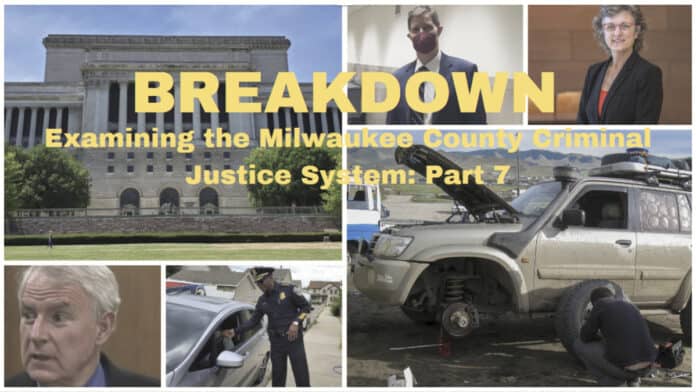PART 7 IN AN 11-PART SERIES. Read parts 1, 2, 3, 4, 5, and 6.
Milwaukee County’s criminal justice system has broken down at almost all levels.
Although some of the breakdown can be attributed to the pandemic, some can not. Local officials’ questionable policy decisions also play a role, and it’s imperiling public safety. The pandemic exacerbated some already existing trends and caused others, but officials have not developed effective strategies to recover. Some non-pandemic-related issues, like the ACLU-related Collins Agreement’s impact on proactive policing and plummeting numbers of police officers (down 26% since 1996) have been largely overlooked in the media.
PROBLEM #7: Milwaukee County jail and prison sentences have plummeted. The number of sentences in Milwaukee courts fell significantly *before* the pandemic, but plummeted further during it and have not recovered.
The number of prison sentences out of Milwaukee County courts dropped 48.6% during the pandemic and, in 2022, were still lower than before it. Local jail sentences dropped by more than 60% when the pandemic hit but the 2022 total was only 895, compared to 2,661 in 2015.
Felony prison sentences are still 15.9% under 2019. This graphic shows the trends, but indicates inaccurately that sentencings have recovered. They’ve started to, but they aren’t there.

Milwaukee County has joined the Safety and Justice Challenge, a program whose “primary purpose of jails is to detain those awaiting trial who are a danger to public safety or a flight risk.” The County’s website explains: “Jailing someone who is neither results in significant costs for families and communities — particularly communities of color — including lost income, parents separated from their children, untreated mental health and substance use challenges, a greater risk of re-offending, and wasted public dollars.” One strategy of the Milwaukee Community Justice Council is listed as follows, “Racial Equity convenes system and community partners to measurably reduce disparities through decision point analysis, shared priority-setting, and training.” In other words, the goal is to reduce jail populations, to some extent.
 THE SERIES:
THE SERIES:
We have taken the lead in exploring the problems in Milwaukee County’s Criminal Justice system since our site launched in 2020, breaking stories on Milwaukee police staffing declines (which started years ago), the DA’s high non-prosecution rate and new reliance on summonses, the 2018 ACLU Collins Agreement’s deleterious effect on proactive policing, new jail and police policies restricting bookings and arrests, and the massive court backlogs, which leave defendants on the streets longer to re-offend and provoke constitutional concerns. Milwaukee is at a crisis point, with record homicide numbers and a severe reckless driving crisis.
Now, a new August 2023 report from the Wisconsin Policy Forum has examined Milwaukee County’s Criminal Justice System in great detail, providing fresh data from 2018 (before the pandemic) to 2022. We are excerpting some of the key statistical findings in our 11-part series to further understanding of the problem. You can’t formulate solutions if you don’t understand the problem’s scope. The few news articles that emerged only superficially skimmed over the report’s findings. The report’s authors are Rob Henken, Ari Brown, and Betsy Mueller.
Although the report deals with the context of the pandemic, it also makes it clear that, in some respects, trends imperiling public safety started before it or have continued, even escalating in some cases, in 2022, after its height. In other words, you can’t blame everything on the pandemic. The report also indicates that, in a number of ways, some problems that escalated during the pandemic have not been resolved by officials even as late as 2022. In other cases, progress has been made.
“Overall, this report has revealed that multiple key points of the justice system pipeline in Milwaukee County are not functioning in the same way or at the same level as they were prior to the pandemic,” the authors wrote. “It is now incumbent upon justice system leaders and state and local policymakers to aggressively explore why that is, to what degree it may have impacted public safety, what progress is being made in remedying the identified challenges, and whether additional resources or other solutions are required to get the system back on track.”
In each article, which we will run over the next 11 days at 7 a.m. every day, we will outline the problems and present the research. After that, we will run a wrap-up article suggesting solutions. What happens in the state’s largest county has an effect throughout Wisconsin. The WPF report was commissioned by the Milwaukee-based Argosy Foundation and the Milwaukee Community Justice Council (CJC). Most of it is focused on useful data. In cases where we think aspects were left out, we will note that. In this series, we hope to get past simplistic rhetoric (“it’s the state Legislature’s fault!” on the left or “who cares what happens in Milwaukee!” on the right.)
PROBLEM #7
The DA’s office “also tracks sentences monthly and annually, both in terms of totals and how many of those convicted go to either local jails or a state prison,” the report says. It found:
- “Total sentences had fallen significantly prior to the pandemic, from 4,342 in 2015 to 3,202 in 2019 (-26.3%). In 2020, they plummeted further, with only 1,445 sentences handed out, a decline of 54.9% from the prior year. Total sentences increased in both 2021 (1,720) and 2022 (2,262), but have yet to return to pre-pandemic levels.”
- “State prison sentences were consistent from 2015 to 2019, never going below 1,600 or above 1,700. However, they fell from 1,639 in 2019 to just 842 in 2020 (-48.6%), before rising to 1,031 in 2021 and 1,367 in 2022.”
- “Local jail sentences fell from 2,661 in 2015 to 1,563 in 2019, but then dropped by more than 60% to just 603 in 2020; the 2022 total was 895, still well below pre-pandemic numbers.”
- “This phenomenon appears to be strongly related to the fact that nearly every misdemeanor that ends with a custodial sentence results in an individual being sent to a local jail, and misdemeanor sentencing has remained far below pre-pandemic levels since March 2020.”
- “Misdemeanor jail sentences had already fallen from 2,121 in 2015 to 1,137 in 2019, but then they dropped to just 392 in 2020 before rebounding modestly to 462 in 2021 and 631 in 2022.”
- “Felony jail sentences have also remained below pre-pandemic levels, dropping by more than half from 2019 (426) to 2020 (211), and remaining below 300 in both years since. However, while felony prison sentences also saw a nearly 50% decline from 2019 (1,620) to 2020 (832), they rose to 1,362 in 2022, just 15.9% below 2019 numbers.”
Table of Contents











![WATCH: Elon Musk Town Hall Rally in Green Bay [FULL Video]](https://www.wisconsinrightnow.com/wp-content/uploads/2022/04/Elon_Musk_3018710552-356x220.jpg)



![The Wisconsin DOJ’s ‘Unlawful’ Lawman [WRN Voices] josh kaul](https://www.wisconsinrightnow.com/wp-content/uploads/2025/03/MixCollage-29-Mar-2025-08-48-PM-2468-356x220.jpg)







![Phil Gramm’s Letter to Wall Street Journal [Up Against the Wall]](https://www.wisconsinrightnow.com/wp-content/uploads/2025/03/gramm-356x220.png)










